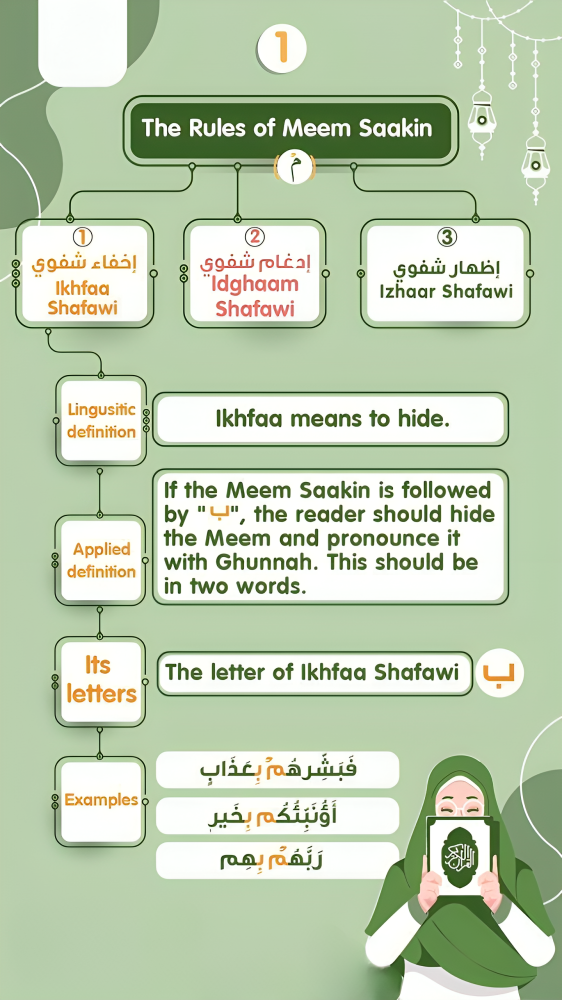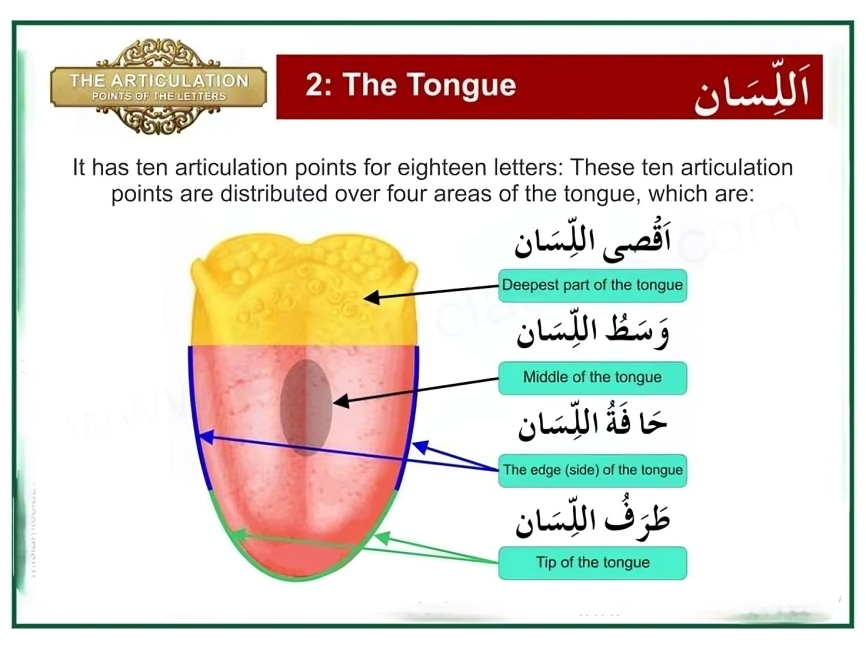Complete Guide to Articulation Points of Arabic Letters: Understanding Makharij Al-Huroof
The Quran is a miraculous revelation that demands precision in its recitation. One of the essential aspects of Tajweed (the art of Quranic recitation) is Makharij Al-Huroof—the articulation points of Arabic letters. Each letter originates from a specific place in the mouth, throat, or nasal cavity, and accurate pronunciation ensures the correct delivery of the Quranic message.
In this blog, we will dive deep into the articulation points of Arabic letters, focusing on the specific roles of الثنایا, الرباعیات, الانیاب, الضواحک, الطواحن, and النواجذ.
What Are Makharij Al-Huroof?
Makharij Al-Huroof refers to the articulation points of letters, which are the specific places in the human anatomy (throat, tongue, lips, teeth, and nasal cavity) where the sound of each letter is formed. Arabic letters are categorized based on their points of articulation, which ensures correct pronunciation and preserves the Quranic meaning.
The 5 Main Regions of Articulation
Makharij Al-Huroof are derived from five main regions:
- The Throat (الحلق)
- The Tongue (اللسان)
- The Lips (الشفتان)
- The Nasal Cavity (الخیشوم)
- The Teeth (الثنایا والأضراس)
Below is a detailed breakdown of each region, including the role of الثنایا, الرباعیات, الانیاب, and others.
1. The Throat (الحلق)
The throat is divided into three parts, producing six Arabic letters:
- Lower Throat (أقصى الحلق): Produces ء (Hamzah) and ه (Ha).
- Middle Throat (وسط الحلق): Produces ع (Ain) and ح (Ha).
- Upper Throat (أعلى الحلق): Produces غ (Ghain) and خ (Kha).
2. The Tongue (اللسان)
The tongue is the most versatile organ in articulating Arabic letters and is divided into multiple sections:
a. Back of the Tongue (أقصى اللسان)
- ق (Qaf): The back of the tongue touches the soft palate.
- ك (Kaf): The back of the tongue touches the hard palate.
b. Middle of the Tongue (وسط اللسان)
- ج (Jeem), ش (Sheen), ي (Ya): Articulated from the middle of the tongue touching the roof of the mouth.
c. Edges of the Tongue (حافة اللسان)
- ض (Dhad): The sides of the tongue press against the molars.
d. Tip of the Tongue (طرف اللسان)
The tip of the tongue produces letters such as:
- ن (Noon), ر (Ra), ت (Ta), د (Dal), and ط (Taa).
3. The Lips (الشفتان)
The lips are responsible for letters like:
- ب (Ba): Both lips close tightly.
- م (Meem): Lips close softly.
- و (Waw): Rounded lips without full closure.
- ف (Fa): The bottom lip touches the upper teeth.
4. The Teeth (الثنایا والأضراس)
The teeth are categorized into groups based on their roles in articulation. Let’s explore each type in detail:
a. Al-Thanaya (الثنایا)
These are the four front teeth, two on the upper jaw and two on the lower jaw. They are responsible for producing letters such as:
- ظ (Zha), ذ (Dhal), and ث (Tha): The tongue lightly touches the edges of these teeth.
b. Al-Rubaiyat (الرباعیات)
Located next to the front teeth, these are the four lateral incisors (two on the upper jaw and two on the lower jaw). They stabilize the tongue when pronouncing certain letters but do not directly produce specific sounds.
c. Al-Aniyab (الانیاب)
These are the four canine teeth (sharp teeth next to the lateral incisors). Like the lateral incisors, they provide support in articulation without directly producing specific letters.
d. Al-Adras (الأضراس)
The molars are categorized into three groups, each playing a role in articulation:
- Al-Dhawahik (الضواحک)
- These are the four first molars, located right after the canines.
- Al-Tawahin (الطواحن)
- These are the four second molars located next to the first molars.
- Al-Nawajidh (النواجذ)
- These are the four wisdom teeth, located at the back of the jaw.
Together, the molars help in articulating the letter ض (Dhad) by pressing the sides of the tongue against them.
5. The Nasal Cavity (الخیشوم)
The nasal cavity is used for producing the Ghunnah (nasal sound), a key feature of letters like:
- م (Meem) and ن (Noon).
The Ghunnah sound is essential in Tajweed rules such as Ikhfa, Idgham, and Iqlaab.
Importance of Learning Makharij Al-Huroof
- Preserves the Meaning of the Quran: Mispronunciation can lead to changes in meaning.
- Fulfills Tajweed Rules: Accurate articulation is a Quranic obligation.
- Enhances Quranic Beauty: Correct pronunciation adds depth to the recitation.
Tips to Master Makharij Al-Huroof
- Seek Guidance: A qualified teacher can help refine your pronunciation.
- Practice Daily: Regular repetition of articulation points builds confidence.
- Use Visual Aids: Diagrams, like the one provided, are great for beginners.
- Listen to Reciters: Emulate renowned Qaris to perfect your recitation.
Learn Tajweed with Baytul Quran
At Baytul Quran, we offer:
- Structured Courses: Learn Tajweed, including Makharij Al-Huroof, with expert teachers.
- Interactive Lessons: Use visuals and practice exercises for better retention.
- Flexible Timings: Study at your convenience.
Start your journey today! Visit us at Baytul Quran and enroll in our Tajweed courses.
By mastering Makharij Al-Huroof, you ensure that your Quranic recitation is accurate, beautiful, and in line with the Prophet Muhammad’s (PBUH) teachings. Begin your journey to perfect recitation today with the Baytul Quran.





